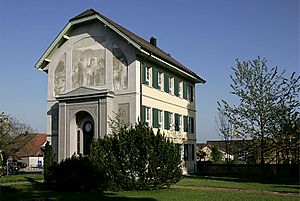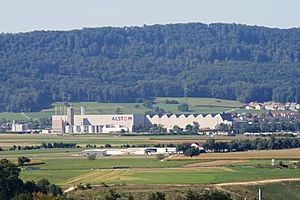Birr, Aargau facts for kids
Quick facts for kids
Birr
|
||
|---|---|---|
 |
||
|
||
| Country | Switzerland | |
| Canton | Aargau | |
| District | Brugg | |
| Area | ||
| • Total | 5.05 km2 (1.95 sq mi) | |
| Elevation | 352 m (1,155 ft) | |
| Population
(Dec 2020 )
|
||
| • Total | 4,598 | |
| • Density | 910.5/km2 (2,358.2/sq mi) | |
| Postal code |
5242
|
|
| Surrounded by | Birrhard, Brunegg, Lupfig, Möriken-Wildegg | |
Birr is a town in Switzerland, located in the canton of Aargau. It's like a small capital for the Brugg area. Birr is found between the towns of Lenzburg and Brugg. It has grown so much that it now connects with its neighbor, Lupfig.
Birr is famous because a Swiss teacher named Johann Heinrich Pestalozzi lived here. He created new ways of teaching that changed education. His grave in Birr is a very important historical site in Switzerland.
Contents
History of Birr
People have found old items from the Roman and Alamanni times in Birr. But there was no known village here back then. The first time Birr is mentioned in writing is in 1270. It was called Bire.
For a long time, the village belonged to the powerful Habsburg family. Later, in 1397 and 1411, the right to rule Birr went to a monastery called Königsfelden Abbey. This monastery was in Windisch.
When the monastery was closed down in 1528, the ruling rights moved to Bern.
The Church and Reformation
The small chapel in Birr used to be part of the church in Windisch. But during the Reformation, it became its own parish church. This new church served several nearby villages. These included Lupfig, Birrhard, Scherz, Schinznach-Bad and Brunegg. The church building you see today was built in 1662. It was designed by Abraham Dünz.
Pestalozzi's Influence
In 1771, Johann Heinrich Pestalozzi bought some unused land in Birr. He called it Neuhof, which means "New Farm". He tried to grow a plant called madder there. Madder was used to make red dye.
Pestalozzi was not good at business, so his farming plan failed. Before this, he had also tried to open a school in his farmhouse. That plan didn't work out either.
However, his later efforts to start schools and develop new teaching ideas were much more successful. He became very famous for his work in education. Later in his life, he faced some difficulties with his school. In 1825, he returned to Neuhof. He wrote about his life and his last book there. He passed away in Brugg.
Since 1914, the Neuhof has been used as a special school.
Birr Becomes Industrial
After 1950, Birr changed a lot. It went from being a farming village to an industrial one. A large factory, BBC (Brown, Boveri & Cie), came to Birr between 1957 and 1965. This factory made big electrical machines.
Along with the factory, about 500 new apartments were built. This caused the town to grow very quickly. By 1990, most people who worked in Birr were commuters. Many worked in factories. Only a very small number of people still worked in farming.
Geography of Birr
Birr covers an area of about 5.05 square kilometers (about 1.95 square miles). A little over one-third of this land is used for farming. Another third is covered by forests. The rest of the land is built up with buildings and roads.
Most of the built-up area is used for factories and homes. There are also roads and some special areas like parks.
Birr is located on the western edge of an area called the Birrfelds. The town has grown together with the nearby municipality of Lupfig. Birr itself is a haufendorf village. This means it's an old, unplanned village with houses built close together around a central area.
Coat of Arms
The coat of arms for Birr shows a golden pear on a blue background. This design is a type of "canting arms". This means the picture on the shield sounds like the name of the place. In German, "pear" is Birne, which sounds like Birr.
People of Birr
Birr has a population of about 4,092 people. A large part of the population are foreign nationals. Most people in Birr speak German. Italian is the second most common language, followed by Serbo-Croatian.
The people of Birr are generally well-educated. Many adults have finished high school or gone on to higher education. In the 2008/2009 school year, there were many students attending primary and secondary schools in the town.
The population of Birr has changed over time:
| Historical population | ||
|---|---|---|
| Year | Pop. | ±% |
| 1850 | 498 | — |
| 1900 | 448 | −10.0% |
| 1950 | 562 | +25.4% |
| 1975 | 2,749 | +389.1% |
| 1980 | 2,838 | +3.2% |
| 1990 | 3,324 | +17.1% |
| 2000 | 3,529 | +6.2% |
Important Heritage Site
The grave site of Heinrich Pestalozzi is a very important historical place. It is located at Pestalozzistrasse 2. This site is listed as a Swiss heritage site of national significance.
Economy of Birr
Birr's economy mostly depends on its industries. Big companies like ABB, GE, and IC Interconnex have factories here.
Many people who live in Birr work outside the town. But also, many people travel into Birr for work. Most workers use a private car to get to work. Some also use public transportation.
Birr also has a regional airfield called Birrfeld. This airfield is used for sport flying. It has a restaurant and a play area, making it a popular place to visit.
Religion in Birr
According to a census from 2000, many people in Birr are Roman Catholic. A good number also belong to the Swiss Reformed Church. There are also a few people who follow the Christian Catholic faith.
See also
 In Spanish: Birr (Argovia) para niños
In Spanish: Birr (Argovia) para niños
Images for kids









